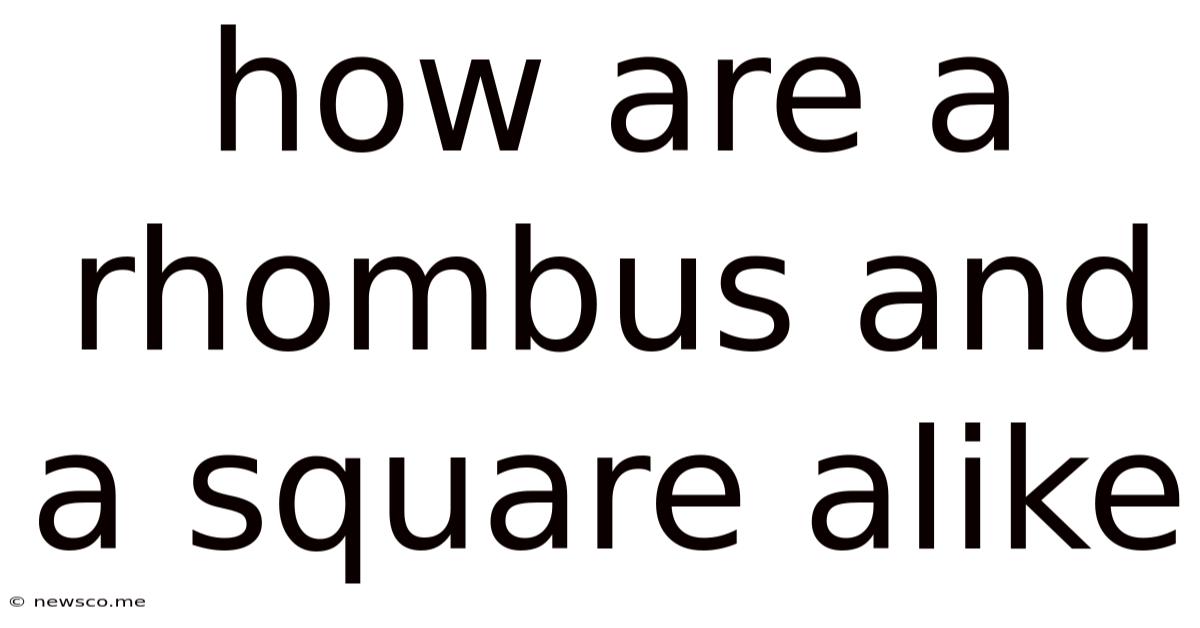How Are A Rhombus And A Square Alike
News Co
Apr 23, 2025 · 4 min read

Table of Contents
How Are a Rhombus and a Square Alike? Exploring Shared Properties and Differences
The world of geometry is filled with fascinating shapes, each with its own unique characteristics. Among these, the rhombus and the square often spark curiosity due to their apparent similarities. While distinct in some ways, these quadrilaterals share a surprising number of properties, making them intriguing subjects for geometric exploration. This article will delve into the similarities between a rhombus and a square, clarifying their shared attributes while highlighting their key differences. Understanding these relationships strengthens foundational geometric knowledge and improves spatial reasoning skills.
Shared Properties: The Foundation of Similarity
The core similarity between a rhombus and a square lies in their shared properties as specific types of parallelograms. Let's break down these crucial overlapping characteristics:
1. All Sides are Equal: The Defining Feature
Perhaps the most striking similarity is that both a rhombus and a square possess four sides of equal length. This characteristic forms the basis of their classification and differentiates them from other quadrilaterals like rectangles or trapezoids. This equality of sides is a fundamental property that underpins many other shared characteristics. Think of it as the cornerstone upon which the similarities are built.
2. Opposite Sides are Parallel: Parallelogram Properties
Both shapes are parallelograms, meaning that their opposite sides are parallel to each other. This parallelism is a direct consequence of the equal side lengths and the angles formed within the shapes. This property allows for several geometric deductions and applications, such as finding the area using the base and height.
3. Opposite Angles are Equal: A Consequence of Parallelism
The parallelism of opposite sides in both rhombuses and squares leads to another shared attribute: opposite angles are equal in measure. This is a fundamental property of parallelograms and directly contributes to the overall symmetry observed in both shapes. This equality of angles is crucial for various geometric calculations and proofs.
4. Consecutive Angles are Supplementary: Adding Up to 180°
In both rhombuses and squares, consecutive angles (angles next to each other) are supplementary, meaning they add up to 180°. This is a direct result of the parallel sides. Understanding this property is vital for solving problems involving angle calculations within these shapes.
Where They Differ: The Distinguishing Characteristics
While sharing several important properties, rhombuses and squares diverge in one crucial aspect that leads to further differences:
1. Angle Measures: The Key Differentiator
The most significant difference lies in their angle measures. A square is characterized by four right angles (90° each). In contrast, a rhombus can have any angle measure for its corners, as long as opposite angles are equal and consecutive angles are supplementary. This means a rhombus can be comprised of acute and obtuse angles, making it far more versatile in its possible shapes than a square.
2. Diagonals and Their Relationships: A Geometrical Distinction
While both shapes have diagonals that bisect each other (meaning they cut each other in half), their diagonals exhibit different properties:
- Square: The diagonals of a square are equal in length and bisect each other at right angles (90°). This creates four congruent right-angled isosceles triangles.
- Rhombus: The diagonals of a rhombus bisect each other at right angles (90°), but they are not necessarily equal in length. This characteristic differentiates it from a square. The diagonals divide the rhombus into four congruent triangles, but these triangles are not necessarily right-angled.
3. Symmetry: Exploring Lines of Reflection
While both shapes exhibit symmetry, their types of symmetry differ slightly:
- Square: A square possesses four lines of symmetry – two lines running through opposite vertices and two lines bisecting opposite sides. It also possesses rotational symmetry of order 4.
- Rhombus: A rhombus has only two lines of symmetry, running through opposite vertices. It possesses rotational symmetry of order 2. This lower degree of symmetry highlights a key difference from the square.
Real-World Applications: Seeing the Shapes in Action
Understanding the similarities and differences between rhombuses and squares has practical applications in various fields:
- Architecture and Engineering: The strength and stability of square structures are well-known. Rhombus shapes, with their ability to withstand various stress patterns, are utilized in bridge construction and architectural designs.
- Art and Design: Both shapes appear frequently in artistic creations, from paintings and mosaics to tessellations and graphic design. Understanding their geometric properties helps artists achieve balance and visual appeal.
- Computer Graphics and Game Development: These shapes are fundamental building blocks in creating complex graphical elements and objects in computer games and simulations.
Conclusion: A Deeper Appreciation of Geometric Relationships
The exploration of the similarities and differences between rhombuses and squares provides a valuable lesson in geometric analysis. Their shared properties emphasize the underlying connections within different shapes, while their distinguishing features highlight the nuances of geometric classification. By understanding these relationships, we can appreciate the richness and complexity of geometric forms and their applications in various fields. This enhanced understanding fosters a stronger grasp of fundamental geometric concepts and improves problem-solving skills in related disciplines. The interconnectedness of seemingly distinct shapes within geometry showcases the beauty and elegance of mathematical relationships. The exploration of these shapes encourages critical thinking and a deeper understanding of the world around us. Remember, the seemingly simple square and rhombus offer a gateway to a world of complex and fascinating geometric principles.
Latest Posts
Related Post
Thank you for visiting our website which covers about How Are A Rhombus And A Square Alike . We hope the information provided has been useful to you. Feel free to contact us if you have any questions or need further assistance. See you next time and don't miss to bookmark.